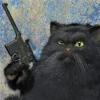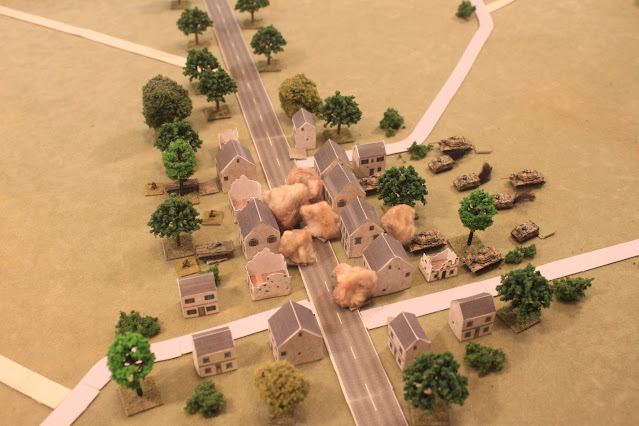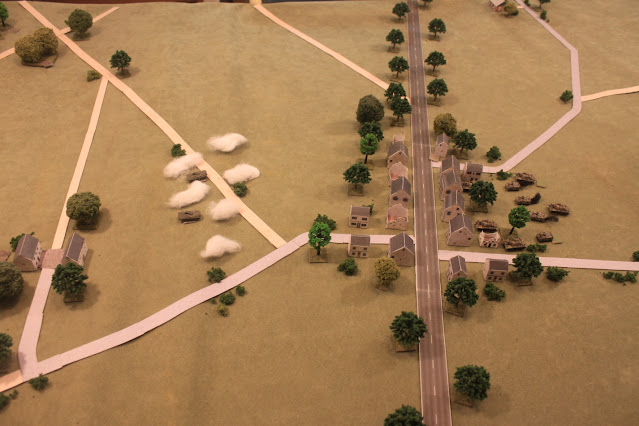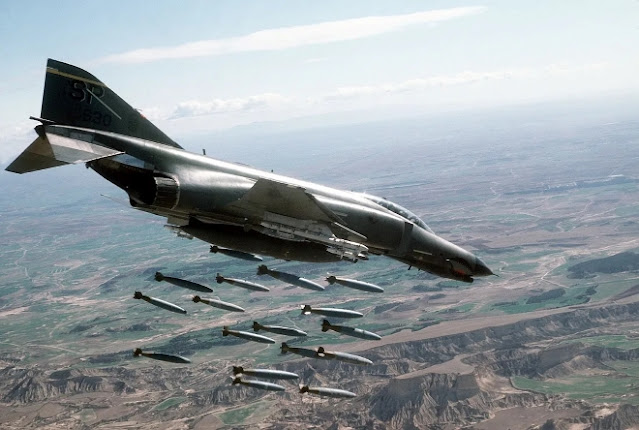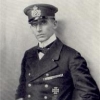Scenario 4 - A Ridge Too Far
Introduction
It's the summer of 1976. Jossa enjoyed a brief period of quiet as the war moved west. The residents who had stayed in Jossa began to pick up the pieces and wonder what the future held in store for them. They didn’t have long to wait. The Americans stopped the Soviet drive and began to push the Soviets back. The locals, now experienced in these matters, had marked the offensive’s progress as the rumble of artillery had drawn closer. When the Soviet Army soldiers began preparing positions on the east ridge above the town and in Jossa itself, they knew that the “red-hot rake of war”, to borrow Churchill’s expression, was coming back to Jossa. Time to get the basements and cellars ready.
Situation
The US V Corps is pushing the Soviets eastwards. Fresh US reserves have been introduced into the fight and these forces have helped drive the tattered Soviet forces east. In this scenario, a reduced Soviet motor rifle company will defend the eastern ridge behind the town of Jossa against a reinforced US mechanized infantry company.
The Battlefield
This is the field of battle. The village of Jossa sits in the center of the table in a shallow valley. The top of the picture is west, the direction from which the Americans will come. The Soviets will be positioned mainly on the east ridge, which is the bottom of the picture. The trees are impassible to tanks, but smaller vehicles like M113s, BMPs and BRDMs can work their way through. The field is 3 kilometers west to east and 1.5 kilometers north to south.
The Soviets
Mission
Defend to eastern ridge behind the village of Jossa. Do not allow the Americans to take the ridge.
Forces Available
The following forces are available to the Soviet player.
On Table:
- 1 x Motor Rifle company (reduced) – 7 x BMP-1; 6 x Motor Rifle squads; 1 x company HQ
- 4 x T-62 tanks
- 1 x Sagger BRDM-2
- 2 x Dismounted Sagger ATGM teams
Off Table:
- 1 x 120mm regimental mortar battery – 6 tubes (on call) with 6 x HE fires and 3 x smoke fires
- 1 x 122mm artillery battery – 6 tubes (on call) with 6 x HE fires and 3 x smoke fires
- Counter battery detection and counter-battery artillery assets
- Anti air defense artillery assets
Plan
The plan is to try to break up, disrupt and slow down the US attack as much as possible before their attack reaches the main defense line. The village of Jossa will be held by a platoon of infantry as a forward position and artillery fires have been plotted in front of and behind the village and in front of the main defense line.
Deployment
The Main Position in the above photo is where the motor rifle company is dug in, the three platoons in line, due to the length of front to cover. The military crest is in front of the Soviet position, out in the open. The Soviets opt to prepare their entrenchments inside the trees to gain the advantage of concealment. A lack of time to prepare means the BMP-1s are not dug in, but concealed and protected as well as possible within the trees. Lanes for fire are cleared so the position is covered, but without compromising concealment.
Positions 'A' are where the dismounted Sagger teams have deployed and dug in. These positions give them flanking shots along the front of the Soviet main defense line. Position 'B' is behind the farm buildings and is occupied by the BRDM-2 Sagger unit. The 'T' positions are where the T-62s are deployed to cover avenues where enemy tanks can penetrate the wood along the ridge line.
The center platoon’s initial position will be in the village of Jossa. It has taken up positions inside the village, away from the village's western edge. This is to minimize vulnerability to direct fires from the enemy and to keep engagement ranges short to counter US indirect fires. An observation post is placed on the western edge of Jossa. This platoon will fall back to the center of the ridge line Main Position for the main defense when directed to give up the Jossa position.
The above photo looks toward the west edge of the table and the expected approach path of the American (indicated by the blue arrow). 'F' indicates the forward Soviet position in Jossa.
The Soviet player is playing with his units hidden until spotted. He also gets dummy counters to further increase the enemy's uncertainty. The dummies are provided at the ratio of one dummy marker for every two actual markers.
The Americans
Mission
The US force, a reinforced mechanized company team, will attack to seize the eastern ridge behind the village of Jossa. This attack is in support of a larger effort to the north to take the towns of Poppenrod and Hosenfeld.
Forces Available
On Table:
- 1 x Mechanized Infantry company (15 x M113s): 3 x Mech platoons (4 x M113s per plt.); 1 x Company HQ (1 x M113); TOW section (2 x M150 TOW carriers)
- 1 x M60A1 tank platoon (5 x M60A1 tanks)
Off Table :
- Mech company mortar platoon (3 x 81mm mortars) , 6 x HE fires, 3 x smoke fires
- 1 x battery of 155mm artillery in direct support (6 guns), 6 x HE fires, 3 x smoke fires
- 1 x F-4 Phantom on-call close air support
- Counter battery detection and counter-battery artillery assets
Plan
The US goal is Objective Blue, the ridge east of Jossa.
The blue arrows indicate the line of approach selected by the US commander. The tracks (APCs) can move through the woods, so they can follow the general path indicated by the arrows. The tanks cannot move through the woods. They will enter the table along the dirt road at the bottom right in the photo above. The trees along Phase Line (PL) Red block the line of sight from the Soviet positions so the approach to PL Red is mostly concealed from the enemy’s view. Once the company team has formed up on PL Red then the move to Jossa and PL White will be made. Once Jossa is secured and the company team has moved up to PL White, the assault on Objective Blue will take place. These advances will be covered by artillery and mortar fires and smoke. Close air support will strike the objective before the final move to Objective Blue begins. The TOW section will provide anti-tank overwatch from PL Red.
The Game
The US begins by advancing two mech platoons towards PL Red, 2nd platoon in the center and 3rd platoon to the left.
These are followed on the next turn by the 1st platoon, the company HQ, and the TOW tracks. The lead platoons move through the trees to the east edge of the woods. The Soviets do nothing at this time.
The US tanks come down the forest road and begin to enter the open area behind PL Red. The US commander has the company mortars fire smoke to obscure the gap in the trees on the south of the advanced group of trees to facilitate the tanks movement across the open space behind PL Red.

As the US tank platoon completes its movement, the US calls down 155mm fire on Jossa to suppress any Soviets on the western edge of the town. Soviet counter-battery fails to locate the US 155mm battery. The US 2nd platoon advances under cover of this fire on Jossa. Unfortunately, the Soviets have called in their own preregistered 122mm artillery fires to land in front of Jossa. It is not a happy meeting with the advancing US platoon. Two tracks are killed and one track is immobilized by the Soviet barrage. Fortunately the US infantry avoid casualties as they dismount from their 113s. Happily for the grunts on the ground, but unbeknownst to them, the US counter-battery system locates the Soviet 122mm battery. US fires kill two Soviet guns. This battery is now suppressed. The Soviets, while losing the use of their artillery for a few turns (as it recovers and relocates) have reduced the US attackers' mobility.
(Note – in the above photo gray smoke is US artillery and brown is Soviet)
The American infantry moves into the town and clear their way to the highway where they encounter Soviet main line of resistance. The US commander decides that 2nd platoon will need some heavy direct fire support so he sends the tanks down to Jossa the help out. The US commander calls for smoke from the 155mm battery to cover the left flank for the advance of the tank platoon. The mission is fired but this time the Soviet counter-battery team locates and fires on the US artillery. No losses to the US guns, but they scoot to a new location.
The firefight in Jossa intensifies. The tanks add their fires and buildings begin to collapse under the blows. The Soviets get an RPG hit and immobilize one M60 tank. An RPG kills another M113. The Soviets begin to take casualties. After five turns of close combat the Soviets decide it’s time to leave. Soviet 120mm mortars are called down on Jossa to cover the Soviet infantry’s pull back to their BMPs.
(Continued ... )












